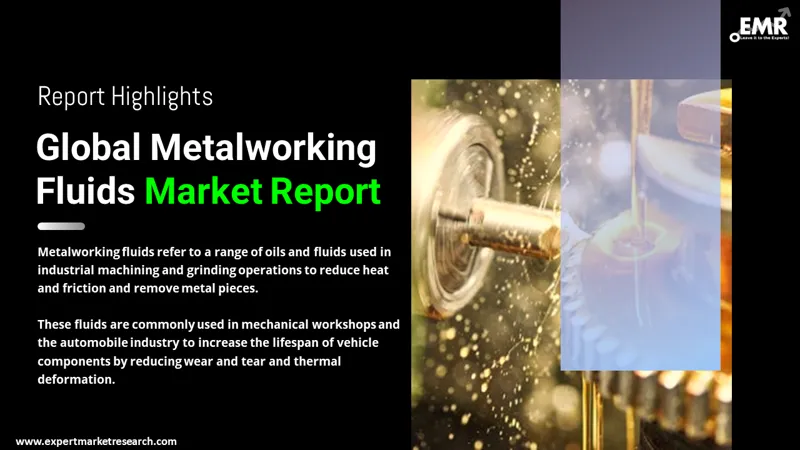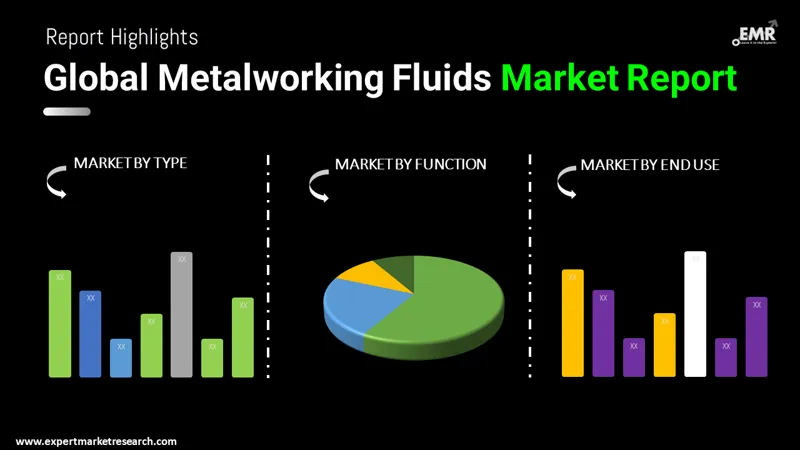
Consumer Insights
Uncover trends and behaviors shaping consumer choices today
Procurement Insights
Optimize your sourcing strategy with key market data
Industry Stats
Stay ahead with the latest trends and market analysis.
The global metalworking fluids market size attained a value of more than USD 12.01 Billion in 2025. The market is expected to grow at a CAGR of 4.10% between 2026 and 2035 to reach a value of USD 17.95 Billion by 2035.
Base Year
Historical Period
Forecast Period
Compound Annual Growth Rate
4.1%
Value in USD Billion
2026-2035
*this image is indicative*
| Global Metalworking Fluids Market Report Summary | Description | Value |
| Base Year | USD Billion | 2025 |
| Historical Period | USD Billion | 2019-2025 |
| Forecast Period | USD Billion | 2026-2035 |
| Market Size 2025 | USD Billion | 12.01 |
| Market Size 2035 | USD Billion | 17.95 |
| CAGR 2019-2025 | Percentage | XX% |
| CAGR 2026-2035 | Percentage | 4.10% |
| CAGR 2026-2035 - Market by Region | Asia Pacific | 4.7% |
| CAGR 2026-2035 - Market by Country | India | 5.4% |
| CAGR 2026-2035 - Market by Country | China | 4.5% |
| CAGR 2026-2035 - Market by Type | Bio Based | 4.6% |
| CAGR 2026-2035 - Market by End Use | Metal Fabrication | 4.8% |
| Market Share by Country 2025 | Germany | 4.4% |

Read more about this report - REQUEST FREE SAMPLE COPY IN PDF
Metalworking fluids is a term given to various oils and fluids utilised for heat and friction reduction and removal of metal pieces during industrial machining and grinding operations. These fluids are utilised worldwide on daily basis in mechanical workshops and in the automobile industry to extend a vehicle component’s life by reducing wear and tear and thermal deformation.
The rapid industrialisation and infrastructural developments in developing countries have surged the demand for metalworking fluids, especially in the Asia Pacific region. This surge in demand can propel the metalworking fluids market growth.
The transportation sector is the largest end-user of metalworking fluids and with the rising demand for commercial and passenger vehicles, the market is expected to develop further.
The manufacturing sector is one of the primary users of metalworking fluids. The development of new manufacturing methods for sophisticated products, coupled with automated equipment, has enhanced the market size.
The demand for lightweight equipment and shifting preference from traditional alloys to stainless steel, aluminium, and titanium, is expected to provide new growth opportunities.
The introduction of multi-functional fluids for high-performance machines and the development of eco-friendly products can provide new growth opportunities to the market.
Due to financial crises around the world and geopolitical conflicts, the price of crude oils can be prone to fluctuations, which can hamper the market growth.
With the rising environmental concerns, governments’ efforts to minimise environmental damage have started to implement strict regulations on the usage of metalworking fluids. This can be a major setback for the market.

Read more about this report - REQUEST FREE SAMPLE COPY IN PDF
The EMR’s report titled “Metalworking Fluids Market Report and Forecast 2026-2035” offers a detailed analysis of the market based on the following segments:
Market Breakup by Type
Market Breakup by Function
Market Breakup by End Use
Market Breakup by Region
Based on function, the market segments include neat cutting oils, water cutting oils, and corrosion preventive oils, among others.
Neat cutting oils are usually based on mineral oils which are used while cutting operations and are commonly used in heavy-duty operations as they provide high levels of lubrication. This segment holds the largest market share due to its application in various industrial operations.
Water-cutting oils are used by mixing concentrates of mineral oils or synthetic oils with water. It is widely used in processing as a coolant and lubricant. This segment is expected to experience significant growth due to its easy availability and excellent heat-carrying capability. However, it does not possess lubricating properties which can lead to corrosion.
Corrosion preventive oils are utilised on metals during the semi-finished or finished stage. They are applied to the metals to form a protective layer the metal, which provides rust protection.
Based on end-use, the market segments include metal fabrication, transportation equipment, and machinery, among others. The machinery segment has been the leading segment in the market as the demand for metalworking fluids has been rising exponentially in industries for application in different types of machines available in the market. Metalworking fluids are expected to show significant growth due to their adoption of these fluids by small-scale enterprises.
The transportation equipment segment is expected to show significant growth during the forecast period due to the rising demand for transportation equipment. The growth of this segment can also be attributed to increasing construction activities, especially in the Asia Pacific region.
| CAGR 2026-2035 - Market by | Country |
| India | 5.4% |
| China | 4.5% |
| Canada | 3.9% |
| Germany | 3.4% |
| Italy | 2.9% |
| USA | XX% |
| UK | XX% |
| France | XX% |
| Japan | 2.8% |
| Australia | XX% |
| Saudi Arabia | XX% |
| Brazil | XX% |
| Mexico | XX% |
The comprehensive EMR report provides an in-depth assessment of the market based on Porter's five forces model along with giving a SWOT analysis. The report gives a detailed analysis of the following key players in the global metalworking fluids market, covering their competitive landscape and the latest developments like mergers, acquisitions, investments, and expansion plans.
Quaker Chemical Corporation is a chemical company and a leader in industrial process fluids, based in the United States and founded in 1918. The company provides their services to multiple industries such as aerospace, mining, steel, tube and pipe, metal finishing, among many other industries.
Blaser Swisslube AG is a chemical company, headquartered in Bern, Switzerland, and it was founded in 1936. The company is engaged in developing, producing, and selling an extensive list of metalworking fluids of high quality and performance for a variety of industries. They provide multiple services including monitoring and maintenance planning, water quality test, and machine preparation training, among many other services for optimal performance of the fluids.
TotalEnergies is a French multinational company for energy and petroleum, headquartered in France and founded in 1924. The company specialises in dealing with oil and gas exploration and production, refining, trading, shipping, crude oil, liquified natural gas, renewable energy, solar energy, wind energy, and geology, among many other fields.
*Please note that this is only a partial list; the complete list of key players is available in the full report. Additionally, the list of key players can be customized to better suit your needs.*
Other market players include Eni S.p.A, Exxon Mobil Corporation, Castrol Ltd, Lubrizol Corporation, and Chevron Corporation, among others.




*While we strive to always give you current and accurate information, the numbers depicted on the website are indicative and may differ from the actual numbers in the main report. At Expert Market Research, we aim to bring you the latest insights and trends in the market. Using our analyses and forecasts, stakeholders can understand the market dynamics, navigate challenges, and capitalize on opportunities to make data-driven strategic decisions.*
Get in touch with us for a customized solution tailored to your unique requirements and save upto 35%!
In 2025, the global market for metalworking fluids reached a size of USD 12.01 Billion.
The market is expected to grow at a CAGR of 4.10% during the period 2026-2035.
The market is expected to reach a value of USD 17.95 Billion.
The market is driven by the increasing demand from a developing automotive industry and rising demand for heavy industrial operations.
The introduction of multi-functional fluids and utilisation of lightweight components are the key trends in the market.
The regional markets for the market include North America, Europe, the Asia Pacific, Latin America, the Middle East and Africa.
The types in the market include mineral, synthetic, and biobased.
The functions available in the market include neat cutting oils, water cutting oils, and corrosion preventive oils, among others.
Metalworking fluids find end-uses in metal fabrication, transportation equipment, and machinery, among others.
The key players in the market include Quaker Chemical Corporation, Blaser Swisslube AG, TotalEnergies, Eni S.p.A., Exxon Mobil Corporation, Castrol Ltd., Lubrizol Corporation, and Chevron Corporation, among others.
Explore our key highlights of the report and gain a concise overview of key findings, trends, and actionable insights that will empower your strategic decisions.
| REPORT FEATURES | DETAILS |
| Base Year | 2025 |
| Historical Period | 2019-2025 |
| Forecast Period | 2026-2035 |
| Scope of the Report |
Historical and Forecast Trends, Industry Drivers and Constraints, Historical and Forecast Market Analysis by Segment:
|
| Breakup by Type |
|
| Breakup by Function |
|
| Breakup by End Use |
|
| Breakup by Region |
|
| Market Dynamics |
|
| Competitive Landscape |
|
| Companies Covered |
|
Datasheet
One User
USD 2,499
USD 2,249
tax inclusive*
Single User License
One User
USD 3,999
USD 3,599
tax inclusive*
Five User License
Five User
USD 4,999
USD 4,249
tax inclusive*
Corporate License
Unlimited Users
USD 5,999
USD 5,099
tax inclusive*
*Please note that the prices mentioned below are starting prices for each bundle type. Kindly contact our team for further details.*
Flash Bundle
Small Business Bundle
Growth Bundle
Enterprise Bundle
*Please note that the prices mentioned below are starting prices for each bundle type. Kindly contact our team for further details.*
Flash Bundle
Number of Reports: 3
20%
tax inclusive*
Small Business Bundle
Number of Reports: 5
25%
tax inclusive*
Growth Bundle
Number of Reports: 8
30%
tax inclusive*
Enterprise Bundle
Number of Reports: 10
35%
tax inclusive*
How To Order

Select License Type
Choose the right license for your needs and access rights.

Click on ‘Buy Now’
Add the report to your cart with one click and proceed to register.

Select Mode of Payment
Choose a payment option for a secure checkout. You will be redirected accordingly.
Gain insights to stay ahead and seize opportunities.

Get insights & trends for a competitive edge.

Track prices with detailed trend reports.

Analyse trade data for supply chain insights.

Leverage cost reports for smart savings

Enhance supply chain with partnerships.

Connect For More Information
Our expert team of analysts will offer full support and resolve any queries regarding the report, before and after the purchase.
Our expert team of analysts will offer full support and resolve any queries regarding the report, before and after the purchase.
We employ meticulous research methods, blending advanced analytics and expert insights to deliver accurate, actionable industry intelligence, staying ahead of competitors.
Our skilled analysts offer unparalleled competitive advantage with detailed insights on current and emerging markets, ensuring your strategic edge.
We offer an in-depth yet simplified presentation of industry insights and analysis to meet your specific requirements effectively.
Share